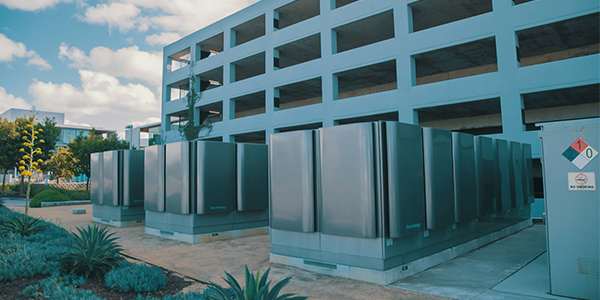FERC on Thursday proposed to include solid oxide fuel cells (SOFCs), a technology commercialized in the last decade, as qualifying cogeneration facilities under the Public Utility Regulatory Policies Act of 1978 (RM21-2, RM20-20).
The commission’s Notice of Proposed Rulemaking would amend its regulations to add the on-site reformation process of SOFCs as “useful thermal energy output” under PURPA.
FERC issued the proposal in response to a petition from SOFC manufacturer Bloom Energy in August. The company said it was not seeking to force electric utilities to buy its output at avoided-cost rates. Rather, it wants to take advantage of PURPA’s provisions reducing barriers to entry for new technologies, including exemptions from regulation under the Public Utility Holding Company Act of 2005, exemptions from some Federal Power Act provisions governing rates and financial organization, and access to interconnection.
“It is in Bloom’s commercial interest to sell to willing buyers, be they commercial customers, electric utilities or others,” said the company, which said it has about 600 installed systems, averaging 600 kW each.
In response to Congress’ 2005 PURPA amendments, FERC adopted the “fundamental use test,” which narrowed the facilities that can invoke a utility’s must-purchase obligation to include only cogeneration facilities for which at least 50% of their “electrical, thermal, chemical and mechanical output” is used for industrial, commercial or institutional purposes, and not intended fundamentally for sale to an electric utility.
Under that test, “even though a Bloom installation would satisfy the proposed definition of ‘useful thermal energy output,’ it would meet the other requirements for certification … only if it did not seek to sell at avoided-costs rates,” the company said.
Bloom did not respond to a request for comment on how PURPA status could aid its technology, which it has sold to tech companies such as Apple, AT&T and PayPal to provide backup power for data centers.
The company, which has never generated a profit in 19 years of operation, disclosed early this year that it would be restating its prior four years’ financial statements to reduce revenue by $192.1 million through Sept. 30, 2019. In an article in February, Forbes reported that the company had raised $1.7 billion of capital, “some of which was raised on the back of false statements.”
Power Without Combustion

Fuel cells convert the chemical energy in hydrogen directly to electrical energy without combustion. SOFCs use a solid oxide ceramic material as their electrolyte — a substance that produces an electrically conducting solution — unlike fuel cells that use platinum or other precious metals. The electrolyte oxidizes hydrogen, converting it to water vapor (H2O) while producing electricity.
SOFC systems that take in natural gas generate hydrogen and electricity by using the steam to reform, or separate, the methane (CH4). “As a consequence, hydrogen-rich fuel enters the anode side of the fuel cell. Simultaneously, ambient air enters the cathode side of the fuel cell,” the company explained. “The hydrogen on the anode attracts oxygen ions from the cathode. The resulting electrochemical reaction produces electricity, plus the heat and steam that is used to continue the reformation of natural gas into fuel.”
Innovation Anticipated
The commission noted that in enacting PURPA, Congress did not limit its definition of cogeneration to the combined heat and power technologies in existence at the time. “Due to innovation and development in the last decade, solid oxide fuel cell systems with integrated natural gas reformation equipment are now a viable option for efficient electric energy cogeneration, furthering PURPA’s goal of encouraging the innovation and development of cogeneration facilities,” it said.
SOFCs can reform multiple fuel types, such as propane or gasoline, to produce their hydrogen fuel. The fuel cells contemplated by FERC’s proposal specifically reform methane on-site.
“If the natural gas reformation equipment were instead located off-site, then waste heat (in the form of steam) from the electricity production by the solid oxide fuel cell would not be available to aid the reformation process to fuel the cell,” the commission said. “In this off-site reformation scenario, we would expect the external reformation process to require additional natural gas to be burned to create steam so that the remainder of the input natural gas could be reformed into hydrogen. This would be inefficient, and inconsistent with Congress’s goal in enacting PURPA.”
Supporters, Opponents

The Edison Electric Institute opposed Bloom’s petition, arguing that the language of PURPA stipulates that the byproduct energy from cogeneration QFs “must be primarily used for industrial, commercial heating or cooling purposes.”
Meanwhile, Democratic Sens. Dianne Feinstein (Calif.), Chris Coons (Del.) and Sheldon Whitehouse (R.I.) wrote in support of the petition. “To meet our clean energy goals, reduce risks of climate-induced disasters and create microgrid-enabled systems, a host of new energy efficient technologies are needed,” they wrote. “If combined heat and power meets the broad standards of a qualifying facility, we believe it is only appropriate that newer, more modern technologies, such as fuel cells, be designated as qualifying facilities as well.”
Comments on the NOPR are due 30 days from its publication in the Federal Register.
According to the Department of Energy, 95% of the hydrogen produced in the U.S. is made by natural gas reforming in large central plants. It is mostly used for industrial purposes, such as refining petroleum, treating metals, producing fertilizer and processing foods, according to FERC. When the carbon that is emitted from the methane reformation process is captured and stored, the hydrogen produced is called “blue hydrogen.”
Last month, DOE announced $34 million in funding for 12 small-scale SOFC projects.




